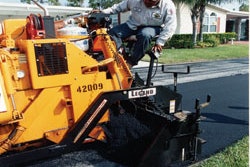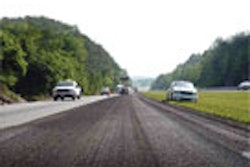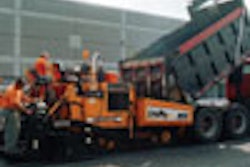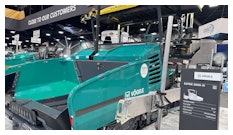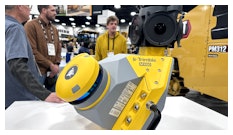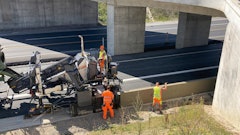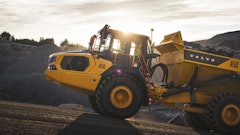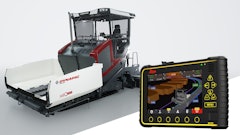An hour of downtime during the paving season can cost thousands of dollars. But how do you avoid such costs? One way is to inspect, maintain and repair equipment idled by colder weather. And if you live where the paving season never ends, there are ways to help prevent costly downtime, too.
Following are some steps to take regarding equipment storage and maintenance.
Colder climates
Make sure your equipment is productive when the warm weather returns. That means catching up on maintenance and storing the equipment properly so it's ready to run when the season arrives.
Generally, replace a part if there is any question that it will fail or wear out during the next paving season.
The most crucial storage step is performing all scheduled maintenance. This includes proper greasing of all lubrication points, as directed by the operator and maintenance manual (OMM), and making sure fluid levels are adequate and fluid changes completed.
When preparing the engine for storage, Caterpillar, for example, recommends the use of volatile corrosion inhibitors, also known as VCI oil, in order to prevent internal engine damage due to moisture during storage. These inhibitors evaporate inside the engine, then condense over the inside surfaces. The process offers full protection of surfaces that cannot be reached with preservatives that require direct application. VCI is removed by simply running the engine to operating temperature. The oil should then be drained and new oil and filters installed.
Diesel fuel left in the fuel tanks and fuel injection systems can sometimes result in plugged fuel filters, corrosion, sticking fuel pumps or malfunctioning fuel injection valves. Minimize these problems by draining the fuel injection pump and refilling it with calibration fluid. To prevent the growth of small organisms in the diesel fuel, use diesel fuel biocide such as Biobor JF or an equivalent.
Cooling systems should be preserved with extended life coolant, which provides the best coolant life, corrosion protection, water pump seal service life and radiator service life. An acceptable alternative is antifreeze.
It's common in warm climates to store the engine with water in the cooling system. In such cases, use distilled or deionized water — not hard tap water or salt softened tap water. Check the OMM for further instructions.
Add protective covers over machines if they will be stored outdoors. If equipment will be exercised, consult the OMM.
Removal from storage
It's very important for the engine to have adequate lubrication during the first few seconds of operation. To prevent the possibility of a "dry start," pressure lubrication of the engine — filling the main oil passages with oil under pressure — is necessary. Be sure to change the oil and filters. Check the fan and alternator belts, and replace if necessary. Tighten the belts as specified in the manual. Replace the fuel filter elements and remove plastic covers from the air cleaner elements. Use a bar (or turning tool) to turn the engine in the normal direction of rotation to ensure there are no hydraulic locks or resistance.
Before starting the engine, remove the valve cover. Put a large amount of engine oil on the camshaft, cam followers and valve mechanism to prevent damage. It's necessary to lubricate the engine to prevent damage in the first few seconds after starting.
Check all rubber hoses and replace if necessary. Before start-up, test the cooling system for a three to six percent concentration of coolant conditioner. If using a fresh water system, ensure the system is clean, full and has the proper amount of supplemental conditioner.
On the first day of operation, check the entire engine several times for leaks and correct operation.
Warmer climates
Of course some crews pave all year round. Still, weather precautions must be taken. Make sure coolant/anti-freeze is at its proper level. In addition, make sure other fluids, such as those sprayed on roller drums, are mixed so they don't freeze.
While the machines might keep working, they also need to be properly maintained.
First, crews should complete visual daily checks to help ensure equipment is running properly. To get a glimpse inside the various machine compartments, Caterpillar dealers, for example, offer many services. These include Scheduled Oil Sampling (S•O•S), which — if done as recommended — can help increase the life of pumps, motors and engines. Ultrasonic wear testing of screed plates and feeder wear components can tell the customer exactly how much has been used — and how much is left. Your local dealer also can measure steel track components for wear, which indicates when the pins and bushings should be turned.
Crews also should track the type of material the paver has handled, the number of miles it has paved and the surfaces it has paved over. Looking at this data can help the technician gauge the wear level of certain components. For example, feeders and augers that handle high amounts of abrasive silicon will wear more quickly than components using limestone-based materials. Maintenance crews should look at how the machines historically have worn while using the particular materials.
Calculating the number of tons a machine placed in a given season is another good indicator of auger and feeder wear. Determining the number of miles paved, meanwhile, helps technicians get a handle on screed plate wear and even the status of the undercarriages. Wear regarding compactors, reclaimers and other equipment also can be gauged by distance and materials covered.
Visual checks pay big dividends
The visual check is as simple as it sounds. An operator opens the hood and verifies the maintenance points. The visual points are clustered, meaning the operator doesn't have to crawl or reach over and under the unit. All the points are accessible and easy to find.
While the visual check is simple and quick, it's also thorough. Operators should check the hydraulic oil level; air cleaner restriction indicator; hydraulic oil filter restriction indicator; fuel system water separator; and dipstick for engine oil.



![Lee Boy Facility 2025 17 Use[16]](https://img.forconstructionpros.com/mindful/acbm/workspaces/default/uploads/2025/09/leeboy-facility-2025-17-use16.AbONDzEzbV.jpg?auto=format%2Ccompress&fit=crop&h=100&q=70&w=100)
